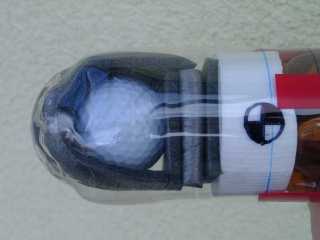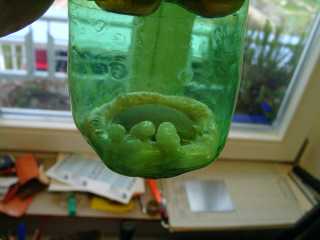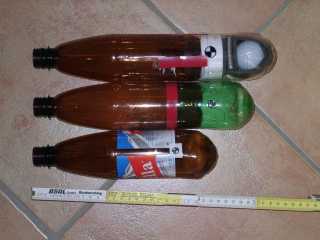Rocket Construction: Gollump Finless Rockets
(in development)
After the discussions in the WR mailing list about different fin materials I kept thinking about simplifying the process of making fins for WR further. The most obvious way would be - NO FINS AT ALL! According to the theory of rocket stability, the only thing what needs to be accomplished is to move the center of gravity (CG) well before the center of pressure (CP).
 |
GOLLUMP 1
I used a golfball, packed in a guppied nose. On the right a 0,5 l Rivella (a Swiss drink) bottle is attached with tape. This rocket did not fly successfully. |
 |
Next step was to make it cheaper and more effective: I put polyurethane (PU) glue into the top of a guppied nose ... |
 |
... adding a 50 gram stone for a CG well at he top of the rocket. Here
it is after the glue has settled. I figured that the glue also would strengthen
the nose on impact when falling from great height. See the slimy up-rise of the glue? That is what reminded my wife of Gollum. Therefore the name of this rocket series is GOLLUMP. |
 |
GOLLUMP 2
This heavy nosepiece was taped to a Rivella bottle, which has a natural nice form towards the end of a rocket (diameter slowly decreasing). Note the CP (middle mark) and CG (right mark). Total weight is 92 grams.
|
 |
GOLLUMP 1, 2 and 3
Altogether I made three rockets following this idea. The "string test" performed very well on all three. But: none flew stable - no crazy corkscrews though, but far from straight up as I am used to and as I had expected from the great results of the string tests. |
 |
To Gollump 2 I added some more weight (a stone and white clay as a
"coupling") to the nose to move the CG even further to the top, as shown
here. The distance from CG to CP is 10 cm, bottle diameter is 6,5 cm. Rocket
theory assumes a stable flight if CG is at least 1,5 times the diameter of
the rocket before CP. Here this is the case - but still, this rocket did
not fly well.
|
At the moment I am thinking about 4 alternatives to improve the design:
- The use of a longer nose cone will increase the distance between CG and CP.
- The mass distribution in the nose cone may be slightly off axis. Next, I will use a heap of gravel instead of one (always asymmetric) piece of stone inside the nose cone.
- The ring where the cable ties are clamping in might produce small eddies, which throw the light tail out of its (otherwise straight) path. Is it worth to reduce the diameter of the ring?
-
Most probably, the addition of little fins will turn this cheap rocket
into a good performer. But: the main advantage of having NO FINS is gone
then ...
Send me an email, if you have got any ideas to evolve this topic.
![]()














